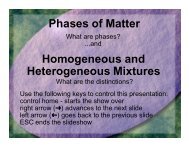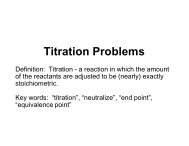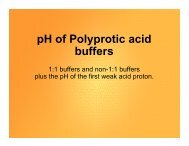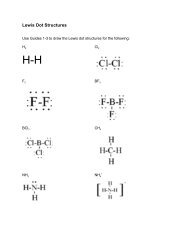van't Hoff factor
van't Hoff factor
van't Hoff factor
Create successful ePaper yourself
Turn your PDF publications into a flip-book with our unique Google optimized e-Paper software.
The (approximate)<br />
van’t <strong>Hoff</strong> <strong>factor</strong><br />
A very important consideration for the colligative properties<br />
See also the handout:<br />
http://www.roanestate.edu/faculty/condon/handouts/vanthoff.html
The van’t <strong>Hoff</strong> <strong>factor</strong><br />
The van’t <strong>Hoff</strong> <strong>factor</strong> is extreamly important when one makes<br />
calculations involving colligative properties. Recall that in<br />
colligative properties the nature of the solute is not important,<br />
only the number of particles.
The van’t <strong>Hoff</strong> <strong>factor</strong><br />
The van’t <strong>Hoff</strong> <strong>factor</strong> is extreamly important when one makes<br />
calculations involving colligative properties. Recall that in<br />
colligative properties the nature of the solute is not important,<br />
only the number of particles.<br />
Consider the situations indicated by the figures below.<br />
neutral<br />
molecule<br />
Na + ion<br />
Cl G ion<br />
}<br />
Water solutions
The van’t <strong>Hoff</strong> <strong>factor</strong><br />
Consider the situations indicated by the figures below.<br />
As far as the solvent is concerned is there any difference?<br />
The neutral molecule and the NaCl are taking up the same<br />
number of positions.<br />
neutral<br />
molecule<br />
Na + ion<br />
Cl G ion<br />
}<br />
Water solutions
The van’t <strong>Hoff</strong> <strong>factor</strong><br />
Consider the situations indicated by the figures below.<br />
As far as the solvent is concerned is there any difference?<br />
The neutral molecule and the NaCl are taking up the same<br />
number of positions. Shown, however are 12 neutral<br />
molecules but only 6 formula units of NaCl.<br />
neutral<br />
molecule<br />
Na + ion<br />
Cl G ion<br />
}<br />
Water solutions
The van’t <strong>Hoff</strong> <strong>factor</strong><br />
Consider the situations indicated by the figures below.<br />
As far as the solvent is concerned is there any difference?<br />
The neutral molecule and the NaCl are taking up the same<br />
number of positions. Shown, however are 12 neutral<br />
molecules but only 6 formula units of NaCl.<br />
Thus, for NaCl the number of moles dissolved needs to be<br />
multiplied by 2!<br />
neutral<br />
molecule<br />
Na + ion<br />
Cl G ion<br />
}<br />
Water solutions
The van’t <strong>Hoff</strong> <strong>factor</strong><br />
This <strong>factor</strong> of 2 for NaCl is the (approximate) van’t <strong>Hoff</strong> <strong>factor</strong>.<br />
This <strong>factor</strong>, given the symbol “i ”, is greater than 1 for all<br />
strong electrolytes.
The van’t <strong>Hoff</strong> <strong>factor</strong><br />
This <strong>factor</strong> of 2 for NaCl is the (approximate) van’t <strong>Hoff</strong> <strong>factor</strong>.<br />
This <strong>factor</strong>, given the symbol “i ”, is greater than 1 for all<br />
strong electrolytes.<br />
i for NaCl = 2 Why? Because NaCl Na + + Cl G<br />
Thus each formal mole of NaCl yields 2 moles of ions in<br />
water.<br />
Consider other electrolytes:<br />
H 2 O
The van’t <strong>Hoff</strong> <strong>factor</strong><br />
This <strong>factor</strong> of 2 for NaCl is the (approximate) van’t <strong>Hoff</strong> <strong>factor</strong>.<br />
This <strong>factor</strong>, given the symbol “i ”, is greater than 1 for all<br />
strong electrolytes.<br />
i for NaCl = 2 Why? Because NaCl Na + + Cl G<br />
Consider other electrolytes:<br />
H 2 O<br />
i for HCl = 2 HCl is a strong acid HCl + H 2 O ! H 3 O + + ClG
The van’t <strong>Hoff</strong> <strong>factor</strong><br />
This <strong>factor</strong> of 2 for NaCl is the (approximate) van’t <strong>Hoff</strong> <strong>factor</strong>.<br />
This <strong>factor</strong>, given the symbol “i ”, is greater than 1 for all<br />
strong electrolytes.<br />
i for NaCl = 2 Why? Because NaCl Na + + Cl G<br />
Consider other electrolytes:<br />
H 2 O<br />
i for HCl = 2 HCl is a strong acid: HCl + H 2 O ! H 3 O + + ClG<br />
H<br />
i for NaOH = 2 NaOH is strong base: NaOH<br />
2 O<br />
Na + + OH G
The van’t <strong>Hoff</strong> <strong>factor</strong><br />
This <strong>factor</strong> of 2 for NaCl is the (approximate) van’t <strong>Hoff</strong> <strong>factor</strong>.<br />
This <strong>factor</strong>, given the symbol “i ”, is greater than 1 for all<br />
strong electrolytes.<br />
i for NaCl = 2 Why? Because NaCl Na + + Cl G<br />
Consider other electrolytes:<br />
i for HCl = 2 HCl is a strong acid: HCl + H 2 O ! H 3 O + + ClG<br />
i for NaOH = 2 NaOH is strong base: NaOH Na + + OH G<br />
H<br />
i for Ca(OH) 2 = 3 a strong base: Ca(OH)<br />
2 O<br />
2 Ca 2+ + 2OHG<br />
H 2 O<br />
H 2 O
The van’t <strong>Hoff</strong> <strong>factor</strong><br />
This <strong>factor</strong> of 2 for NaCl is the (approximate) van’t <strong>Hoff</strong><br />
<strong>factor</strong>. This <strong>factor</strong>, given the symbol “i ”, is greater than 1 for<br />
all strong electrolytes.<br />
i for NaCl = 2 Why? Because NaCl Na + + Cl G<br />
Consider other electrolytes:<br />
i for HCl = 2 HCl is a strong acid: HCl + H 2 O ! H 3 O + + ClG<br />
i for NaOH = 2 NaOH is strong base: NaOH Na + + OH G<br />
i for Ca(OH) 2 = 3 a strong base: Ca(OH) 2 Ca 2+ + 2OHG<br />
i for H 2 SO 4 = 2! 1st H is strong: H 2 SO 4 +H 2 O ! HSO 4 G +H 3 O +<br />
H 2 O<br />
H 2 O<br />
H 2 O<br />
H 2 O<br />
i for FeCl 3 = 4 all salts are strong: FeCl 3 Fe 3+<br />
+ 3Cl G
The van’t <strong>Hoff</strong> <strong>factor</strong><br />
Summarizing the examples:<br />
i for NaCl = 2<br />
H<br />
NaCl<br />
2 O<br />
Na + + Cl G<br />
i for HCl = 2<br />
HCl + H 2 O ! H 3 O + + ClG<br />
i for NaOH = 2<br />
H<br />
NaOH Na + + OH G<br />
2 O<br />
i for Ca(OH) 2 = 3<br />
H<br />
Ca(OH) 2 Ca 2+ 2 O<br />
+ 2OHG<br />
i for H 2 SO 4 = 2 H 2 SO 4 +H 2 O ! HSO G 4 +H 3 O +<br />
H<br />
i for FeCl 3 = 4 FeCl 3 Fe 3+ + 3Cl G<br />
2 O<br />
H<br />
i for Na 2 S = 3 Na 2 S<br />
2 O<br />
2Na + + S 2G
The van’t <strong>Hoff</strong> <strong>factor</strong><br />
Summarizing the examples:<br />
i for NaCl = 2<br />
H<br />
NaCl<br />
2 O<br />
Na + + Cl G<br />
i for HCl = 2<br />
HCl + H 2 O ! H 3 O + + ClG<br />
i for NaOH = 2<br />
H<br />
NaOH Na + + OH G<br />
2 O<br />
i for Ca(OH) 2 = 3<br />
H<br />
Ca(OH) 2 Ca 2+ 2 O<br />
+ 2OHG<br />
i for H 2 SO 4 = 2 H 2 SO 4 +H 2 O ! HSO G 4 +H 3 O +<br />
H<br />
i for FeCl 3 = 4 FeCl 3 Fe 3+ + 3Cl G<br />
2 O<br />
H<br />
i for Na 2 S = 3 Na 2 S<br />
2 O<br />
2Na + + S 2G<br />
But what about nonelectrolytes and weak electrolytes?<br />
These are all approximately 1.
The van’t <strong>Hoff</strong> <strong>factor</strong><br />
Summarizing the examples:<br />
i for NaCl = 2<br />
H<br />
NaCl<br />
2 O<br />
Na + + Cl G<br />
i for HCl = 2<br />
HCl + H 2 O ! H 3 O + + ClG<br />
i for NaOH = 2<br />
H<br />
NaOH Na + + OH G<br />
2 O<br />
i for Ca(OH) 2 = 3<br />
H<br />
Ca(OH) 2 Ca 2+ 2 O<br />
+ 2OHG<br />
i for H 2 SO 4 = 2 H 2 SO 4 +H 2 O ! HSO G 4 +H 3 O +<br />
H<br />
i for FeCl 3 = 4 FeCl 3 Fe 3+ + 3Cl G<br />
2 O<br />
H<br />
i for Na 2 S = 3 Na 2 S<br />
2 O<br />
2Na + + S 2G<br />
But what about nonelectrolytes and weak electrolytes?<br />
These are all approximately 1.<br />
CH 3 OH (methanol an organic) i = 1<br />
CH 3 COOH (a weak acid) i = 1<br />
CH 3 OCH 3 (dimethyl ether an organic) i = 1<br />
NH 3 (a weak base) i = 1
The van’t <strong>Hoff</strong> <strong>factor</strong><br />
Summarizing the examples:<br />
i for NaCl = 2<br />
H<br />
NaCl<br />
2 O<br />
Na + + Cl G<br />
i for HCl = 2<br />
HCl + H 2 O ! H 3 O + + ClG<br />
i for NaOH = 2<br />
H<br />
NaOH Na + + OH G<br />
2 O<br />
i for Ca(OH) 2 = 3<br />
H<br />
Ca(OH) 2 Ca 2+ 2 O<br />
+ 2OHG<br />
i for H 2 SO 4 = 2 H 2 SO 4 +H 2 O ! HSO G 4 +H 3 O +<br />
i for FeCl 3 = 4<br />
H<br />
FeCl 3 Fe 3+ 2 O<br />
+ 3Cl G<br />
i for Na 2 S = 3<br />
H<br />
Na 2 S 2Na + 2 O<br />
+ S 2G<br />
CH 3 OH (methanol an organic) i = 1<br />
CH 3 COOH (a weak acid) i = 1<br />
CH 3 OCH 3 (dimethyl ether an organic) i = 1<br />
NH 3 (a weak base) i = 1<br />
These <strong>factor</strong>s are approximate and the true values, due to<br />
other subtle effects, are slightly different. We will ignore<br />
these subtleties in General Chemistry.
The (approximate)<br />
van’t <strong>Hoff</strong> <strong>factor</strong><br />
Now that you know what the van’t <strong>Hoff</strong> <strong>factor</strong> is, proceed to<br />
the slideshow on the application of the van’t <strong>Hoff</strong> <strong>factor</strong>.<br />
THE END for the slideshow “The (approximate) van’t <strong>Hoff</strong><br />
<strong>factor</strong>”.<br />
See also the handout:<br />
http://www.roanestate.edu/faculty/condon/handouts/vanthoff.html

















